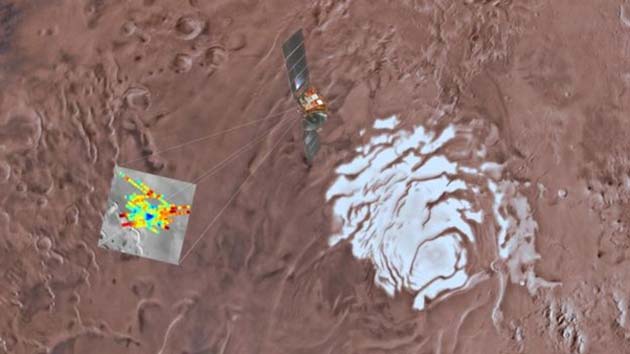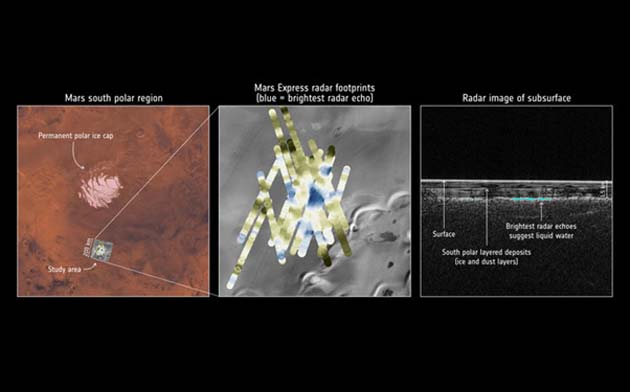The upcoming missions to further explore and investigate the Red Planet for habitability are informed by findings that there may be water when the new spacecraft arrives there. However, this water was thought to exist in locations other than the surface of Mars, and not necessarily in the form that it appears on Earth. These apprehensions now seem to have been vindicated.
The latest data to be analyzed on this subject is likely to correspond to a whole body of water located under the planet’s outer crust.
How Water Was Located on Mars
This water was found near the Southern Pole of Mars. It was located and identified using radar sensors attached to the Mars Express, a satellite-like craft associated with the European Space Agency (ESA).
Telemetry may confirm earlier work that increased the plausibility of water on, or rather, in Mars. This data was actually gathered by the Mars Advanced Radar for Subsurface and Ionosphere Sounding instrument, (MARSIS) the first of its kind to orbit an exoplanet.
MARSIS collected information on the structure and features of Mars beneath its surface, using a relatively simple and well-validated method. The process involved bouncing radar signals off the planet and absorbing the returning signals as data.
This reflecting-radar technique and its interpretation have also been applied to the poles of the Earth and their glaciers, water bodies and how they interacted.
It was this expertise that allowed ESA scientists, led by Roberto Orosei of Italy’s National Institute of Astrophysics, to determine that the signals were most likely to correspond to an entire body of liquid water, buried at a depth of up to 1.5 km (0.9 miles) under the Martian surface.

Artist’s impression of the data representing the ‘lake’ (darkest blue) as seen via MARSIS’ radar. (Source: USGS Astrogeology Science Center, Arizona State University)
Liquid ‘Lake’ of Water on Martian Surface
The Italian scientists were also able to determine that this ‘surface’ was, in fact, made of ice, as concluded in previous, similar studies. However, how could the lake remain liquid, in that case? The answer could be the same as that found under the surface at Earth’s own poles. The presence of ice in such great quantities may alter the pressure, and, thus, the melting point of the water below it.
In addition, Orosei and his team attributed some properties of the reflected signals to the presence of adulterants in the water. Based on the data from this and prior studies, these contaminants were most likely to be sediments, salts or both.
The presence of salt in the water would also make sense of the resistance to freezing, apparently exhibited by the water.
The researchers reported that the body of water as a whole could be as much as 20 kilometers (12 miles) wide and possibly about 1 meter (3.2 feet) in depth. Should these findings hold true in the future, the newly-discovered Martian feature could be classified as a lake.
The water was also one of the ‘brightest’ radar-signal anomalies in the 200-kilometer expanse of the Martian pole that the team was able to study. The lake appeared a blue blob in some colorimetric representations of the radar data.

A schematic showing the area of the Martian surface covered in the study and the ‘bright’ (or blue) returning radar signals indicating the lake’s presence. (Source: NASA/Viking; THEMIS background: NASA/JPL-Caltech/Arizona State University; MARSIS data: ESA/NASA/JPL/ASI/Univ. Rome; R. Orosei et al, 2018)
Does This Mean Life on Mars is Possible?
Some correspondents and thinkers are already taking the discovery as an encouraging sign that life will be found on Mars in future missions to the planet. Others believe that the body of water will most closely resemble the salt lakes of Earth. These geographic features typically contain high levels of salts and minerals that make them hostile to most forms of higher life.
On the other hand, it is possible that extremophile bacteria may be found in these environments. This possibility may also translate to the prospect of exobiology on Mars, provided that the new lake is really one.
This new revelation about what may be found under the surface of Mars may also substantiate another theory about its past. This states that the planet was once home to abundant volumes of water. However, its proximity to the Sun (in addition to some other factors such as ionizing radiations) rendered the planet impossible to support surface water on Mars, over time.
The relatively sparse amounts of liquid receded under the surface and exist to this day in packed layers of dust and water molecules. Alternatively, it formed robust ice at the poles, which may, in turn, inadvertently protect liquid bodies located underneath them.
This theory may help explain how the lake came to be where it is (or is thought to be). However, it does not answer the question of how the water in it got on the planet in the first place.
Orosei and his team have published their findings in the journal Science.
The researchers are now more optimistic that there are similar features on Mars waiting to be found in the course of future projects.
This study may also inform the investigations of Lake Vostok, a feature recently discovered in Antartica. Coincidentally, its known properties, to date, closely resemble that of the ‘lake’ found under the Martian South Pole. Therefore, we may have a very good idea of what to expect if we ever visit the Martian ‘Vostok’ more directly in the future.
Top Image: Artist’s impression of Mars Express above the surface of Mars. (Source: ESA)
References
Mars Express detects liquid water hidden under planet’s south pole, 2018, ESA News, http://www.esa.int/Our_Activities/Space_Science/Mars_Express/Mars_Express_detects_liquid_water_hidden_under_planet_s_south_pole , (accessed 26 Jul. 18)
Mars Express: probing the polar regions, 2018, ESA News, http://sci.esa.int/mars-express/51824-4-probing-the-polar-regions/ , (accessed on 26 Jul. 18)
Liquid water 'lake' revealed on Mars, 2018, BBC, https://www.bbc.co.uk/news/science-environment-44952710, (accessed 26 Jul. 18)
R. Orosei, et al. (2018) Radar evidence of subglacial liquid water on Mars. Science.







No comment